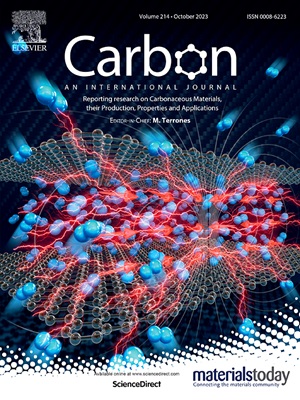Nanostructure engineering of superhard nano-polycrystalline diamond by compressing different fullerene precursors
IF 10.5
2区 材料科学
Q1 CHEMISTRY, PHYSICAL
引用次数: 0
Abstract
Nano-polycrystalline diamond (NPD) is an important material with great application potential in various fields, including tool machining, high-pressure science, etc. Due to the strong covalent bonding structure, introducing controllable nanostructures, such as dislocations and twinned boundaries, into NPD to tune its properties remains challenging and our understanding of the underlying mechanism is also limited. In this work, we discovered a fundamentally important factor/mechanism that influences the formation of nanostructures in NPD, i.e., the reactivities of C–C bonds on fullerene cages affect the formation of intermediate phases and thus the final formed NPD. Our experiments and simulations reveal that the lower reactivity of C–C bonds on C70 cages leads to more ordered graphitic carbon formation, while C60 tends to amorphization under the same HPHT. This results in more complex twinning and stacking faults in the synthesized NPD from C70 than C60 through different transition mechanisms via the intermediate phases. The as-synthesized NPD samples from different fullerenes thus exhibit tunable hardness (85.5–101.7 GPa) and optical properties. Our findings provide new insights into the formation mechanism of diamond nanostructures and propose a new strategy to tune the nanostructures of the synthesized NPD for harder and stronger materials.

求助全文
约1分钟内获得全文
求助全文
来源期刊

Carbon
工程技术-材料科学:综合
CiteScore
20.80
自引率
7.30%
发文量
0
审稿时长
23 days
期刊介绍:
The journal Carbon is an international multidisciplinary forum for communicating scientific advances in the field of carbon materials. It reports new findings related to the formation, structure, properties, behaviors, and technological applications of carbons. Carbons are a broad class of ordered or disordered solid phases composed primarily of elemental carbon, including but not limited to carbon black, carbon fibers and filaments, carbon nanotubes, diamond and diamond-like carbon, fullerenes, glassy carbon, graphite, graphene, graphene-oxide, porous carbons, pyrolytic carbon, and other sp2 and non-sp2 hybridized carbon systems. Carbon is the companion title to the open access journal Carbon Trends. Relevant application areas for carbon materials include biology and medicine, catalysis, electronic, optoelectronic, spintronic, high-frequency, and photonic devices, energy storage and conversion systems, environmental applications and water treatment, smart materials and systems, and structural and thermal applications.
 求助内容:
求助内容: 应助结果提醒方式:
应助结果提醒方式:


